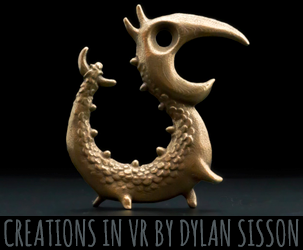


Nimona: Fluidity is Life
By Maria Elena Gutierrez
Like its titular protagonist, Netflix’s animated feature “Nimona” is not afraid to change shape before our eyes. More than that – the movie delights in shifting its form precisely when we least expect it. The result is a film that is charming, sassy, and constantly surprising.
The surprises are there from the very beginning. A prologue tells the story of Gloreth (Karen Ryan), a legendary heroine who once saved the kingdom from a ravening monster, through the medium of illuminated storybook pages. Immediately afterwards the film catapults us into a dazzling ‘techno-medieval’ future where swords and subways exist side by side.
The ruler of this future world is Queen Valerin (Lorraine Toussaint), who sanctions the idea that even common people can become knights of the realm. As a representative of the authoritarian status quo, the Director (Frances Conroy) promptly arranges to have Valerin killed. This unexpected death is followed by a classic cinematic fade-to-black, heralding the first appearance of Nimona (Chloë Grace Moretz) herself.
Nimona’s entrance completes the process of subverting our expectations. Have they really killed off the queen in the first reel? What happened to the traditional fairy tale we were expecting? As Nimona tells us when we find her spraying graffiti on to a propaganda poster, “This ain’t that kind of story.” Later she mixes things up even more by stating, “It’s time to rewrite this story.”
Even though this is a story of queens and kingdoms, it is clear from the start that Nimona is not an old-school storybook princess. Her stocky stature immediately sets her apart from other female characters in the film, such as the Director – who possesses a beauty based more on classical ideals. Her physicality simultaneously identifies her as a powerful individual who knows her own mind and appears comfortable in her own skin.
Only when we discover what lies beneath Nimona’s skin do we begin to appreciate her true nature. Nimona is a shapeshifter, capable of transforming her outward appearance in the blink of an eye. For many people, this makes her a monster – indeed, we soon learn that Nimona is the monster, the so-called ‘Great Black Monster’ vanquished by Gloreth centuries earlier. Fear of this monster has grown into a terror of anything regarded as ‘other,’ resulting in an isolated kingdom that hides behind a barrier wall and where people are taught to fear outsiders. Far from the usual fantasy realm with beautiful forests and golden spires, this is a sinister authoritarian state.
The concept of shapeshifting dips deep into the mythological well, and carries echoes of Ovid’s “Metamorphoses” and other classical works. In “Nimona,” shapeshifting is used as a way of undermining conventional ideas about gender. Here is a character whose physical appearance is fluid in space and time and who, when asked by her new companion Ballister Boldheart (Riz Ahmed) what her natural form is, can answer only by giving her name: “I’m Nimona.” Her name is all she has, but her name is everything. Nimona’s recognition of this fact – and her ability to state her name aloud – is an assertion that she is entirely herself, and not what others want her to be.
By opening a window into Nimona’s heart, the film challenges our ideas about what a monster really is. Nimona is only a monster because Gloreth cast her in that role. Thanks to Gloreth’s propaganda and the relentless weight of tradition, Nimona is doomed to be forever the outsider. She knows this and so, when a child tries to stab her simply because she is different, she says eloquently: “And I’m the monster?”
This is the truth that Ballister ultimately sees, when he says to Nimona: “I see you – you are not alone.” Thanks to the empathy machine that is cinema, we the audience see it, too, in a moment of enlightenment that invites us to question what we perceive as ‘otherness.’ This applies not only to members of the LGBTQIA+ community, but to anyone perceived by society to be ‘different.’ At the same time, the diverse casting feels effortless, creating a kingdom whose population is diverse but never self-consciously so.
The great strength of “Nimona” is that it explores all these complex themes with tremendous wit and humor. As a character, Nimona is feisty and full of malevolent fun, with a quick-witted quip for every occasion. As such, she is the perfect foil to the anxious, introspective Ballister. The dynamic between these two characters – reminiscent of Don Quixote and Sancho Panza – creates a wonderful rhythm that sustains the film perfectly throughout its well-judged runtime. Countless pop culture references and a hip musical score make it easy for modern audiences to relate to the material – these characters might live in a fantasy world, but they enjoy pizza just like the rest of us.
The rhythm is further enhanced by innovative variations in animation style. Old and new combine to create something fresh, fascinating and – like the storyline – filled with surprises. The character animation blends broad humor with subtle emotion, another kind of transformation that enables Nimona to switch from demonic cackle to the most subtle of heart-rending expressions, all in the blink of an eye. Meanwhile, the storytelling shifts effortlessly from fully-rendered animation to the telling of Nimona’s back-story through the charming medium of tiny wall tiles.
The meticulously-designed world of “Nimona” mixes illuminated manuscripts and golden armor with flying cars and cyberpunk. Production designer Aidan Sugano drew inspiration from modern-era illustrators like Eyvind Earle and Charley Harper, and audiences will surely spot nods to movie classics like “Blade Runner” and “The Matrix,” and the futuristic visions of concept designer Syd Mead.
The colors pop off the screen. Most vivid of all is the fiery pink that is Nimona’s signature hue. In addition, color defines both character and mood – contrast the institutional gold-and-white armor of Ambrosius Goldenloin (Eugene Lee Yang) with Ballister’s greys and blacks. The same opposition is present in the environments, with the crisp, shiny castle contrasting dramatically with the soft warmth of Ballister’s hideaway.
But it is in Nimona’s shapeshifting ability that the movie’s true power lies. It drives a number of joyful action sequences showcasing Nimona’s rapid-fire transformations between animals including a rhino, a whale, a gorilla and – most memorable of all – a show-stopping shark. Nimona’s ultimate transformation into the Great Black Monster even evokes memories of classic movie monsters like Godzilla.
Shapeshifting also powers some intensely emotional scenes. For example, when the Director appears to kill Ambrosius in cold blood, we are initially horrified – distraught at the idea that evil has triumphed over good. The consequent revelation that it was Nimona impersonating Ambrosius all along, that she is still alive and kicking, and that it was all a ploy to get the Director to confess to her crimes, is a true air-punch moment of triumph.
This clever bait-and-switch, with its lightning change of perspective, enables the viewer to be both actor and witness in turn. This circles all the way back to the film’s central theme of gender dynamics, by inviting us to see the world through the eyes of the ‘other.’ The icing on the cake is that Nimona casually remarks to Ballister that she has never even taken an acting class. Far from robbing the moment of its drama, this meta-textual comment only makes us love her even more.
The film’s greatest triumph is that we do love Nimona. We love her humor, her boundless energy, and her fluidity in a world where everyone is expected to remain static. Fluidity is movement, which means that fluidity is animation – in the truest sense of the word, derived as it is from the Latin ‘anima,’ meaning ‘soul.’
When Ballister asks Nimona what would happen if she stopped shapeshifting, she tells him she would die. When he questions this, she says: “I wouldn’t ‘die’ die. I just sure wouldn’t be living.” This, then, is Nimona’s final word on the subject, steering us to an inevitable conclusion.
Fluidity is life.
Dr. Maria Elena Gutierrez is the CEO and executive director of VIEW Conference, Italy’s premiere annual digital media conference. She holds a Ph.D. from Stanford University and a BA from the University of California Santa Cruz. VIEW Conference is committed to bringing a diversity of voices to the forefront in animation, visual effects, and games. For more information about the VIEW Conference, visit the official website: http://viewconference
Subscribe to the VIEW Conference YouTube channel:
https://youtube.com/c/viewconf
Facebook: https://facebook.com
YouTube: https://youtube.com/c
Twitter: @viewconference
Instagram: view_conference
VIEW Conference newsletter: Sign up here
#viewconference



























